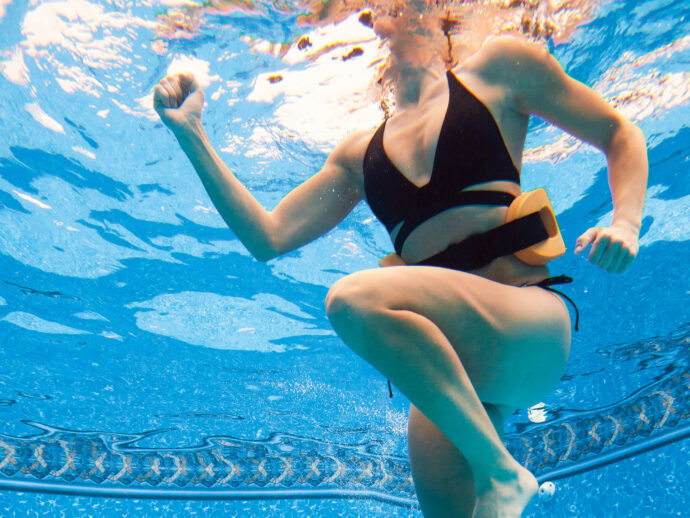
Running in deep water challenges your fitness without overstressing your joints. Do your body a favour by swapping out the concrete and plunging into the pool for your next cardio workout.
Imagine this: it’s six weeks until your first half-marathon and you’ve just been handed the runner’s death sentence: your physiotherapist has advised you to stop running. Your goal of making it even to the start line becomes very fuzzy almost immediately. An alternate activity to maintain your fitness and morale while rehabilitating is key. The unique properties of water make deep water running an excellent alternative.
Let’s dive in
Deep water running (DWR) is running performed in water deep enough to cover the shoulders and keep the feet off the bottom of the pool. Some people prefer to run in place by tethering themselves to the side of the pool, while others choose to travel up and down a lane. To maintain proper form and to ease apprehension, a flotation device, such as a flotation belt, is highly recommended. It’s not uncommon to overuse the upper body when a flotation aide isn’t worn.
Water’s special properties
The presence of buoyancy and drag make running in water a challenging workout without the repetitive stress that running on land brings. This makes DWR an excellent form of cross-training, maintaining our fitness while giving our muscles and joints a break from the usual loads we place upon them. Taking time off our regular weight-bearing activities also goes a long way toward preventing injury.
Land versus water
Investigations of injured and non-injured runners have shown that DWR can maintain and, in some cases, even increase cardiovascular fitness and running performance on land. Researchers have also found the muscle activation patterns to be similar to land running. Overall, science supports DWR as a safe and effective alternative to running on land.
Picking a style
There are two popular techniques used when running in deep water. The high-knee style resembles stair climbing or marching in place, while the cross-country version is similar to a fast run on a treadmill or on land.
The latter technique is preferred for its similarity to land running, especially with regard to ankle motion, and therefore has better carry-over effect. However, for those who need to limit their hip range of motion due to injury, or need to strengthen their hip flexors, the high-knee technique is recommended. Overall, familiarity with technique, comfort in the water, and practice are keys to the success of DWR.
Preferred technique
- slight forward lean, as if running up a small incline
- arms swinging from the shoulders, just like running on land
- knee lifting toward the surface of the water (60 to 80 degrees at the hip)
- sole of foot perpendicular to the bottom of the pool (90 degree angle at the ankle) when knee is raised
- leg extending toward bottom of pool, keeping knee slightly bent and foot lightly pointed as you reach for the bottom of the pool
Injuries or conditions that benefit from DWR
| Injury or condition | Explanation |
| fibromyalgia | DWR is thought to be safe and effective for reducing pain and improving general health and quality of life. |
| stress fractures of the lower leg | DWR allows rest from weight bearing while maintaining cardiovascular fitness. |
| non-specific low back pain | As a component of an individualized physiotherapy program, DWR is effective at decreasing pain and disability and improving range of motion, muscle strength, and endurance. |
Don’t leave your shoes on deck
Research supports the idea of wearing specialized aquatic training shoes in the pool, as they tend to increase the amount of energy expended during a pool run.
Don’t let boredom stop you
Boredom is a realistic concern with pool running. Here are a few strategies to help pass the time more enjoyably.
- Perform interval workouts (see Pyramid Run above as an example).
- Place your music or podcast-listening device in a waterproof bag and secure it under a swim cap or specialized underwater case so you can listen to your favourite tunes.
- Recruit a friend to join you.
Avoid these common errors
- doggy paddling your arms (hold fists slightly clenched to avoid this)
- cycling motion of the legs
- using a swim kick
- leaning too far forward or backward







